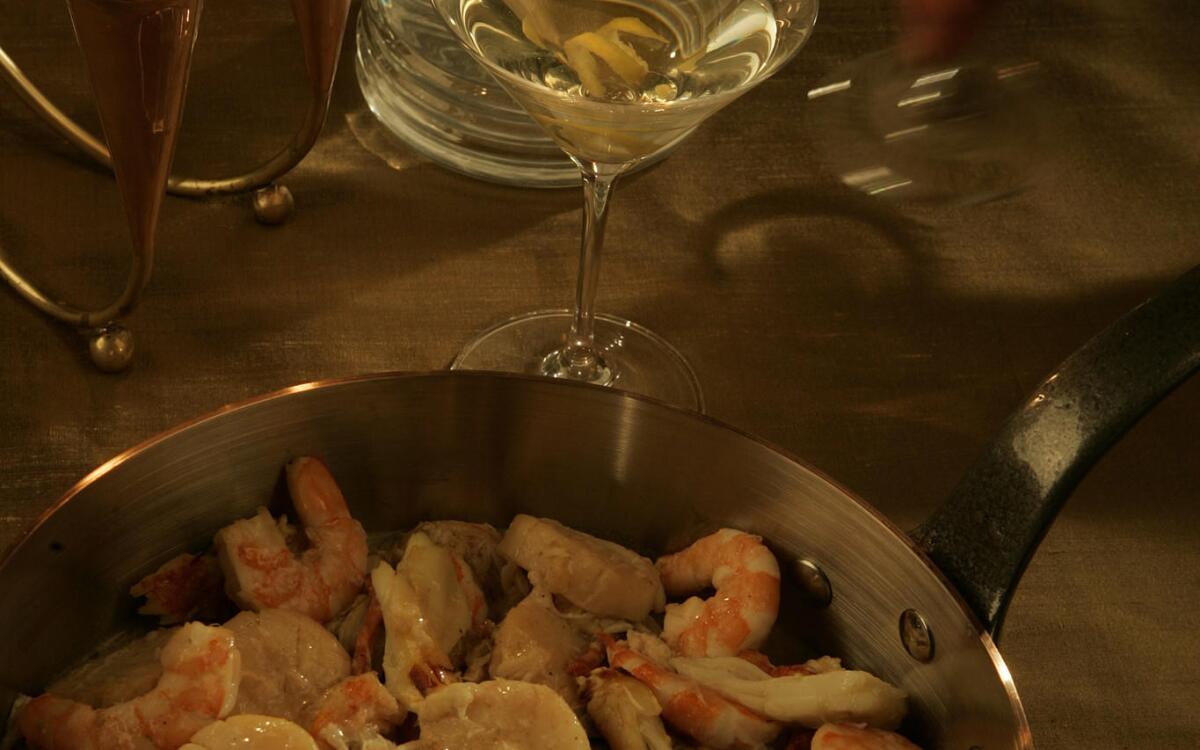Seafood pan roast with chorizo

EXCEPT when it comes to caviar, effortless extravagance sounds like a contradiction in terms. But there is no better description of a seafood pan roast.
This is the most luxurious indulgence: oysters or other shellfish awash in cream or pan sauce enhanced with only the subtlest seasonings, so that the essential brininess shines through. In the most classic version, a slice of toasted bread is included to soak up all that great flavor and richness. Nothing could be more perfect for a holiday entree with so little effort.
To make this exercise in excess at its simplest, you heat cream with seasonings, warm shellfish in butter and combine the two. If you want to take a more restrained route, you can substitute dry vermouth or white wine for the cream. Either way, you get a fabulously festive main course in minutes.
And it is totally attuned to this particular out-with-the-old, in-with-the-new holiday. Pan roasts are seductively retro but can be as food fashion-forward as you want them to be. The classic is obscenely satisfying, and it only gets better with 2008 tweaks such as smoked paprika or cilantro as a garnish.
Pan roasts have an added attraction for New Year’s Eve. They go well with the classic elixirs of the night, whether martinis or Champagne or just a serious white wine, especially one with origins in the Loire or Alsace. Any of them will balance the serious richness of the dish, and the combination feels as special as foie gras and Sauternes but as accessible as an omelet and a glass of Shiraz.
You won’t find listings for pan roast recipes in indexes to most seafood cookbooks, not even under the most common component, oysters. If you find recipes for seafood stews, you understand the basic idea, though neither name is entirely accurate about the cooking process involved. Because most types of shellfish cook so fast you can eat them raw, either roasting or stewing would be brutal treatment. Add “pan” in front of either of those techniques and the result is faster and more delicate. Pan poaching might be closer to what happens, but even that takes more time and work.
Riffs on the basic recipe
James BEARD, a guy who would know, gives two variations on pan roasts in his “American Cookery.” One calls for heating oysters in a stick of melted butter with chili sauce, salt, Tabasco and Worcestershire sauce just until the edges curl; the other uses cream and oyster liquor along with the flavorings. Both are meant to be served over toast.
Pan roasts are among the signature dishes at the venerable Grand Central Oyster Bar in New York City, where cooks can be seen at lunchtime ladling and pouring nonstop from special pots to fill soup plates. Unlike the 94-year-old restaurant’s seafood stews, the roasts -- priced 50 cents higher -- contain a slice of bread and a shot of chili sauce that gives them a pale orange color and jazzier flavor. The menu offers a choice of oyster, cherrystone clam, Ipswich clam, shrimp, lobster or scallop pan roasts, or a combination, with all of the preceding awash in cream (actually half-and-half).
As good as those pan roasts are, the Heinz chili sauce, clam juice and celery salt called for in the “official” recipe disseminated in countless cookbooks and all over the Internet do give them an industrial, almost brassy flavor. Substituting coarse-grain mustard, whether Creole or Pommery, pushes the dish more toward elegance. A slice of good country white bread, lightly toasted and barely buttered, will soak up the sauce so you end with seafood flavor to the last bite.
Pan roasts in Pacific Northwest cookbooks omit the cream but are just as sumptuous because the butter is unstinting: The seafood is almost poached in it, then removed; vermouth or wine is added to make a pan reduction. Throw a little Spanish chorizo in and you get even more intense flavor.
Any seafood will work in a pan roast, whether cooked (lobster, crab), just-shucked (clams, oysters) or shelled (shrimp, mussels). And any variety of any of those types will do fine; just buy what looks best at the fishmonger.
Fast cooking is key to keep it all from turning rubbery. (Shrimp on the small side are advisable, simply because they will cook in about the same time as oysters or scallops.)
As for the rest of the mini-feast, this is one entree that should be followed rather than preceded by salad, preferably one with a fair hint of bitterness to it (frisee or endive) along with a lot of pungent greenery (mesclun, arugula, watercress). To finish, a lemon tart or fruit-based dessert sounds more alluring than anything with chocolate.
And the starter? You could keep it simple by serving a selection of salumi. But this is about effortless extravagance. Open the caviar.
Heat a large skillet over medium heat. Add the chorizo and cook quickly until it starts to turn crisp, a minute or two. Remove with a slotted spoon and drain on a paper towel. Add the butter to the fat remaining in the pan, then add the shallots and saute until very tender, about 3 minutes.
Add the scallops and shrimp and cook, stirring constantly, until the scallops start to turn translucent. Add the oysters and cook quickly, then add the crab and swirl until heated through. Using a slotted spoon, transfer to a warm serving bowl. Add the chorizo and toss to mix.
Raise the heat to medium-high and add the vermouth. Cook, stirring occasionally, until the sauce is emulsified. Add lemon to taste, then season with pepper to taste and salt if needed. Spoon over the seafood and serve.
Get our Cooking newsletter.
Your roundup of inspiring recipes and kitchen tricks.
You may occasionally receive promotional content from the Los Angeles Times.















